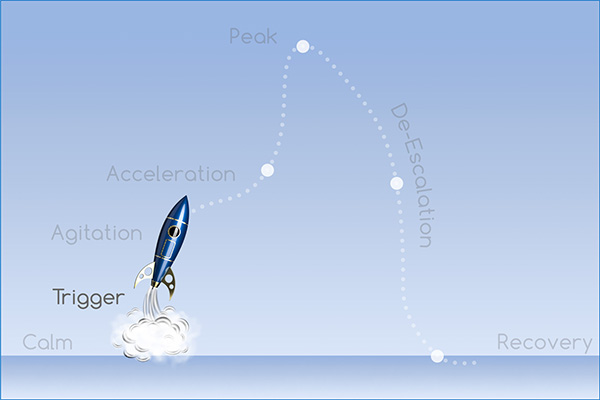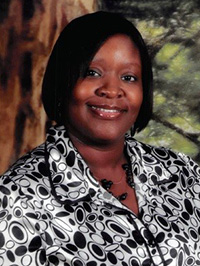How can educators recognize and intervene when student behavior is escalating?
Page 4: Trigger
 If calm behavior is not maintained, some students may move out of the Calm Phase and into Phase 2—the Trigger Phase. This phase can happen suddenly and seemingly without warning. Students are often triggered or “set off” by an issue or concern either left unaddressed or inadequately resolved. Triggers can take place within the school environment, outside of school, or a combination of both. As such, a teacher may not have observed a trigger that occurred within a previous classroom, in the hallway, lunchroom, bathroom, or at home. See the table below for some common school-based and non-school-based triggers.
If calm behavior is not maintained, some students may move out of the Calm Phase and into Phase 2—the Trigger Phase. This phase can happen suddenly and seemingly without warning. Students are often triggered or “set off” by an issue or concern either left unaddressed or inadequately resolved. Triggers can take place within the school environment, outside of school, or a combination of both. As such, a teacher may not have observed a trigger that occurred within a previous classroom, in the hallway, lunchroom, bathroom, or at home. See the table below for some common school-based and non-school-based triggers.
| School-Based Triggers | Non-School-Based Triggers |
|
|
What a Student Looks Like
In the Trigger Phase, some unmet need creates an unresolved problem for the student. This can trigger a behavior that may go unnoticed by the teacher. In this phase, a student may appear:
- Restless
- Frustrated
- Anxious
In this video, note the behaviors that Ava displays during the Trigger Phase (time: 3:13).
Transcript: Trigger Phase
Teacher: All right, everyone, awesome job on that review. You can go ahead and move your whiteboard and your marker to the corner of your table. For the rest of the class, we’ll continue researching the historical figure you all chose for your project. You can go ahead and open your notes and get your tablets and get started on your project. As you all are working, I’ll be walking around the classroom, so if you have a question, just raise your hand for me.
[Ava raises her hand.]
Teacher: Yes, Ava.
Ava: You didn’t assign me a person.
Teacher: That’s because you were supposed to choose a historical figure that we discussed yesterday. So go ahead and open your notes and choose a person so you can get started on your project.
[Ms. Harris circulates around student desks.]
Teacher: Thanks, everyone, for getting started.
[Ava distracts a peer by showing him her tablet. They laugh.]
[ Johanna Staubitz commentary ]
So the class has now transitioned from that fun, competitive activity to some independent work that hinges on something the students did yesterday: the historical figure they identified. And we see right away that Ava is confused about who that historical figure should be. And she raises her hand and asks the teacher. But it’s not just that. There’s something else going on here too. And we can tell because Ava asks the question of Ms. Harris in a really challenging way. In fact, she doesn’t ask a question. She simply says, “You didn’t assign me a person.” And so that’s our first hint that Ava is no longer calm. There has been a trigger and her behavior has begun to escalate. And Ms. Harris then gives Ava information to help her select a person, but clearly doesn’t recognize that there might be something more going on here. So it’s really important for Ms. Harris in a situation like this to be looking for signs of a trigger and to know her students, especially students whose behavior tends to escalate the way Ava’s does and to know what their triggers are. And so in all likelihood, the real issue here for Ava is that they’ve transitioned away from somewhat a context in which she really thrives, that competition and high interest instructional material and a lot of high quality peer attention and teacher attention, “Oh, good job, Ava! You’re winning,” to independent desk work in which really no attention from peers or the teacher is available. And even if it is, it’s not at the interest level that it was during the game. So, A it’s important for Ms. Harris to know Ava’s triggers and look for them, such as that trigger of transitioning from a high preference activity to a low preference activity and build in maybe some extra time and space, but also redirecting her back to the task that she’s trying to avoid isn’t enough. It’s not going to resolve that issue of the difficulty of the transition. It really just serves to reiterate that she needs to be working in a way that she’s not particularly ready to do right now. So then at the end of this video, we see Ava engage a peer and become off-task, which just suggests that Ms. Harris’ intervention and redirection was not sufficient to resolve the trigger. And so we unfortunately can expect further escalation from this point.
Strategies To Implement
Fortunately, teachers can use strategies to prevent behavior from escalating into more serious phases of the acting-out cycle. These strategies can help teachers to anticipate and effectively respond to a student’s trigger(s). When teachers work to prevent or properly address triggers, it is more likely that a student’s challenging behavior will de-escalate, causing them to return to the Calm Phase. However, if a student’s concerns are not properly addressed, it is almost certain that the behavior will escalate, moving to the next phase in the acting-out cycle. The table below includes steps to take, as well as tips teachers can use to address triggers.
| Steps | Tips |
|
|
|
x
precorrection Behavior strategy that entails reminding a student of appropriate behavior before the student can make an error; can be given either to groups of students or to an individual student.
|
|
|
If strategies used in this phase are successful, the student will return to the Calm Phase. In this video, Ms. Harris intervenes effectively to interrupt the acting-out cycle at the Trigger Phase and helps Ava return to the Calm Phase (time: 3:00).
Transcript: Trigger Phase with De-escalation Strategy
Teacher: All right, everyone, awesome job on that review. Now go ahead and place your whiteboards and markers at the corner of your table. For the rest of the class, we’ll continue researching the historical figure that you all chose for your project. So you can go ahead and open your notes and get your tablet and get started. As you all are working, I’ll be walking around the classroom, so if you have any questions, just raise your hand.
[Ava raises her hand.]
Teacher: Yes, Ava.
Ava: You didn’t assign me a person.
Teacher: You were supposed to pick someone we talked about yesterday in class, so go ahead and pick a person and get started on your project.
[Ms. Harris circulates around student desks.]
Teacher: Thanks for getting started, everyone.
[Ava distracts a peer by showing him her tablet. They laugh.]
Teacher: [laughs] Very funny you guys. Please get started on your project.
[ Johanna Staubitz commentary ]
In this video, the same things happened. Ms. Harris announces that the game is over and transitions the class to independent work. And then when Ava says, “You didn’t assign me a person” and subsequently engages the peer with the tablet, this time Ms. Harris kind of casually engages with them as she redirects them. And this is a nice strategy to use humor when redirecting students so that you’re kind of a part of the joke rather than, you know, being distinct from it and in opposition to the joke that the students are having together. So she says, “Very funny guys,” you know, “Get back to work.” And that’s actually successful here. And with students who are middle school or high school level, humor can be a really important tactic because so much depends on the relationship between teacher and student. So I think just one more thing that’s important to note about using humor is that the relationship they have is important. So Ms. Harris has already done the groundwork for a humorous redirect to be something that’s likely to get students back on track. If she had the history of behaving reactively when students act out, then that joking isn’t as likely to be effective. So it’s very important they already have that relationship built. Furthermore, by joking about it, Ms. Harris isn’t making a big deal of it and turning it into a power struggle. And one other thing that she did here that I like is that she directed both students and not just Ava. And so the less emphasis we can place on one individual, the more chance we have in cases like this to get really the student who we’re most concerned about, or the target student, back on-task.
In this interview, Kathleen Lane discusses how to anticipate and manage known triggers to interrupt the acting-out cycle. Next, Janel Brown explains how teachers can prevent triggers from occurring.

Kathleen Lane, PhD, BCBA-D
Professor, Department of Special Education
Associate Vice Chancellor for Research
University of Kansas
(time: 2:25)
Transcript: Kathleen Lane, PhD, BCBA-D
As we think about triggers, when you have students who appear to be struggling regularly, you might consider connecting with them and perhaps a family member to see how you can best support that student. When it is not possible to work with the student or their family, you might just walk through these steps yourself. There are many non-school-based things that you can’t manage. For example, I may not be able to solve major problems such as financial distress for families, but if I know that a student has not had breakfast, I can make arrangements for the school cafeteria folks to have an extra breakfast available for them. And in this way, that student can come in, eat first thing, so that they can be fed and ready to learn. Similarly, if you have a student that’s constantly truant or tardy, then you can meet with that student and say, “You know, these last three days I’ve noticed you’ve been late every day. Can you tell me a little bit about what’s going on? Is there anything I can do to help you to get to school on time?” And it could be that they’d say something along the lines of, “Well, I don’t have an alarm clock at my house, and nobody will wake me up. And so I get up and I still have to make my lunch and find my clothes and that kind of thing.” So you might think about saying to them something along the lines of, “How can we better handle the night before? What about if you packed your lunch the night before, so that’s ready to go? How would you feel about maybe even laying out your school clothes the night before? So you have everything you need, like your shoes, your socks, and all that kind of stuff.” And thinking through this in a problem-solving fashion, you can help them on the front side so they don’t run into those problems that they’re confronted with first thing in the morning when they wake up. And for students that don’t respond well to schedule changes, there can be another strategy called pre-correcting that happens beforehand. So even when it’s exciting things and sometimes when it’s not exciting things [laughs], you can still use that pre-correction strategy and it could look like this: “Now, remember, this week we’re having an assembly, and while we’re all going to be super excited about being there, it’s super tempting to get loud when we’re excited, but we still have to make sure that we’re keeping things cool and under control.”
When we think about clarifying the parameters of what you expect before that day gets there, if you’re going on an early college visit, we just want to make sure that you have clarified the parameters so that you can keep them safe and really help them to have an enjoyable time wherever you are. So the goal here is to anticipate and manage known triggers so that we can interrupt the acting-out cycle before things really get started.
Transcript: Janel Brown
You can identify triggers once you get to know your kids and you build that relationship. Most of the time it’s because of an assignment that they just don’t understand. They’re not going to raise their hand and say, “This is hard. I can’t do this.” They will sit there and struggle through it or get upset. They don’t want their classmates to think, “Oh, you know, she’s dumb.” But once you build that relationship with your students, you get to know them, you know when something triggering is going on. So, you just have to be very vigilant in watching your students and the body language, the slump in the chair, head back, heads down, they’re doodling with stuff. It’s avoidance. They’re trying to avoid whatever it is that you’ve given them to do.
As a gen ed teacher, what you can do ahead of time is if you know that this hard assignment is going to be a trigger for Johnny, maybe you’re just going to put one of those hard math problems on a sheet instead of Johnny seeing the sheet with ten problems. You can have a cheat sheet posted in front of your classroom. These are the steps to solve this type of problem so that when Johnny is working, he can look up, he can see those steps posted for him. Maybe there is a cheat sheet that he can keep on his desk in his folder that he can use to help him figure out these problems. You try to do anything to lessen the trigger factor. You just try to find what works for that student, and you plan for it ahead of time. It’s all about getting to know Johnny and know what his triggers are. What can I do ahead of time to help lessen that trigger for Johnny?
Activity
As you review Sam’s behavior in this video, think back to what you learned about him in the Challenge.
Transcript: Trigger Phase
Teacher: I’ll give you all some time to read through the text by yourself. While you’re reading, I want you to go ahead and take some notes and evaluate the author’s argument using textual evidence. Also, when you’re finished reading, I want you to go ahead and write up a discussion question for me. Okay?
[Sam sighs heavily.]
From the options below, select the most likely trigger for Sam’s behavior.
- What behaviors does Sam exhibit that indicate he is in the Trigger Phase?
- Explain how Ms. Harris could have prevented Sam’s trigger and interrupted the acting-out cycle. Provide an example in your response.
Now watch the video below and compare your above suggestions with Ms. Harris’ actions. You may type your answers in the field below the video. However, this field is provided for reflection purposes only; your answers will not be available for downloading or printing.
Transcript: Trigger Phase with De-escalation Strategy
Teacher: I’ll give you all some time to read through the text by yourself. As you’re reading, you can take notes and evaluate the author’s argument using textual evidence. When you’re finished reading, I also want you to write up a discussion question.
[Sam sighs heavily.]
Teacher: Just to help everyone get started, I’m going to write these up here so you know what to do. [Teacher writes steps on the board.] All right so, one: You’re going to read the text. Then, while you’re reading the text, you can go ahead and take some notes. Next, you will evaluate the author’s argument. And then you will write a discussion question.
Now that you’ve had a chance to reflect, listen to Johanna Staubitz’s feedback (time: 2:00).

Johanna Staubitz, PhD, BCBA-D
Associate Professor
Department of Special Education
Vanderbilt University
Transcript: Johanna Staubitz, PhD, BCBA-D
The most likely trigger for Sam’s behavior in this scenario was the delivery of multi-step instructions; specifically, those instructions were delivered verbally. There’s no permanent product of them. While Sam appears to be listening to her instructions, he’s looking at her, you’ll notice, if you watch carefully, there’s this alarmed look on his face once you realize it’s time for him to do something. You miss the instructions. And this can feel really stressful, especially for a student who wants to blend in. We know Sam’s a quiet student, not as comfortable with speaking up with a question or request. So it’s not so easy for him to just say, “Hey, I missed that.” And the behaviors that we see from Sam that indicate he’s in the Trigger Phase include flipping through his materials, sighing heavily, leaning back in his chair. And those signs are really subtle. So a teacher really has to look for those things.
To prevent the trigger, Ms. Harris could keep in mind that Sam and probably other students in her class would benefit from written instructions. Sam is likely not the only student who struggles to remember a whole list of things that have to be done and would benefit from them being written down. So what Ms. Harris can do is just deliver those instructions verbally while writing them on the board or including them on a handout and restating them. I would even say she could go a step further. And this again would benefit everyone, not just Sam, and check for understanding with the class before releasing them to that independent work. Ask somebody, “Okay, what’s the first thing you’re going to do?” Have them repeat back. “All right, somebody else tell me what you’re going to do when you’re finished reading the passage.” And so on and so forth.
So we’ve just discussed what Ms. Harris could do to prevent a trigger. In our De-escalation Strategy video, we saw what she did to de-escalate once the trigger had occurred. And so the same thing happened in this video: Sam missed the verbal instructions. But this time, Ms. Harris notices and goes ahead and writes the instructions on the board while restating them, which directly resolves that trigger.
